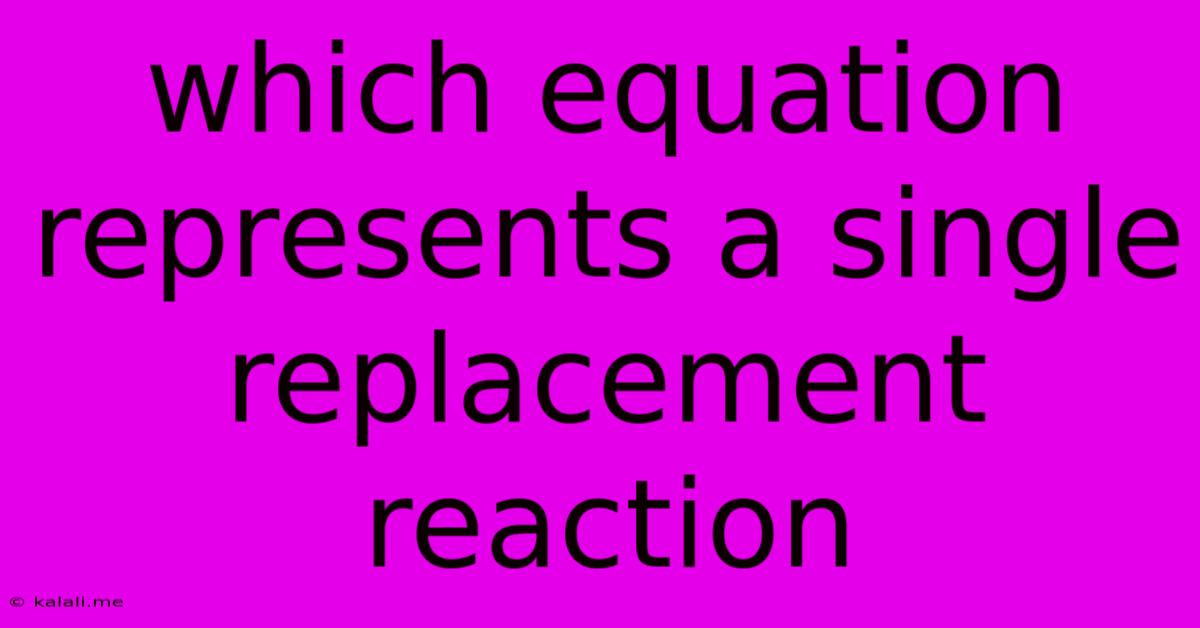Which Equation Represents A Single Replacement Reaction
Kalali
May 10, 2025 · 3 min read

Table of Contents
Which Equation Represents a Single Replacement Reaction? Understanding Single Displacement Reactions in Chemistry
Single replacement reactions, also known as single displacement reactions, are a fundamental type of chemical reaction where one element replaces another element in a compound. Understanding how to identify these reactions from their chemical equations is crucial for any chemistry student. This article will explain what characterizes a single replacement reaction and how to identify the correct equation representing it.
What is a Single Replacement Reaction?
A single replacement reaction follows a general pattern: A + BC → AC + B. Here, element A is more reactive than element B, allowing it to displace B from its compound BC. This reaction only occurs if A is higher on the reactivity series than B. The reactivity series is a table ranking elements according to their tendency to lose electrons and undergo oxidation.
Key characteristics of a single replacement reaction include:
- One element replaces another: A single, uncombined element reacts with a compound to produce a new element and a new compound.
- Involves oxidation and reduction: The element being replaced (B) undergoes reduction (gains electrons), while the replacing element (A) undergoes oxidation (loses electrons). This is a redox reaction.
- Often involves metals and solutions: Many common examples involve a metal reacting with an aqueous solution of a salt or acid.
Identifying the Correct Equation:
To determine if an equation represents a single replacement reaction, examine the reactants and products carefully. Look for the following pattern:
- Reactants: You should have one element and one compound.
- Products: You should have a new element and a new compound. The new element will be a product of the reaction, and it is the element that is displaced. The new compound will be formed by the remaining element and the reactant element that has displaced it.
Examples of Equations Representing Single Replacement Reactions:
Let's analyze some examples to understand better:
-
Zn + 2HCl → ZnCl₂ + H₂: This equation represents a single replacement reaction. Zinc (Zn) replaces hydrogen (H) in hydrochloric acid (HCl), forming zinc chloride (ZnCl₂) and hydrogen gas (H₂). Zinc is higher on the reactivity series than hydrogen.
-
Fe + CuSO₄ → FeSO₄ + Cu: This is another example. Iron (Fe) replaces copper (Cu) in copper sulfate (CuSO₄), resulting in iron sulfate (FeSO₄) and copper (Cu). Iron is more reactive than copper.
Equations that Don't Represent Single Replacement Reactions:
It's equally important to identify equations that don't fit the pattern:
- 2H₂ + O₂ → 2H₂O: This is a synthesis (combination) reaction, where two elements combine to form a compound.
- CaCO₃ → CaO + CO₂: This is a decomposition reaction, where a single compound breaks down into simpler substances.
- NaOH + HCl → NaCl + H₂O: This is a double replacement (or metathesis) reaction, where two compounds exchange ions.
In Conclusion:
Recognizing a single replacement reaction hinges on identifying the pattern of one element displacing another within a compound. By carefully examining the reactants and products and considering the reactivity series, you can accurately determine whether a given chemical equation represents this specific type of chemical reaction. Remember to look for the characteristic exchange of one element for another in a compound, resulting in a new element and a new compound. This understanding is key to mastering chemical equations and predicting the outcomes of chemical reactions.
Latest Posts
Latest Posts
-
Jaguar Adaptations In The Tropical Rainforest
May 10, 2025
-
How To Find Average Velocity From Velocity Time Graph
May 10, 2025
-
What Is Non Living Things In The Ecosystem
May 10, 2025
-
How Many Fl Oz In 6 Cups
May 10, 2025
-
What Is 1 Percent Of 5000
May 10, 2025
Related Post
Thank you for visiting our website which covers about Which Equation Represents A Single Replacement Reaction . We hope the information provided has been useful to you. Feel free to contact us if you have any questions or need further assistance. See you next time and don't miss to bookmark.